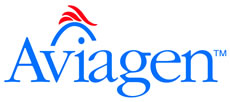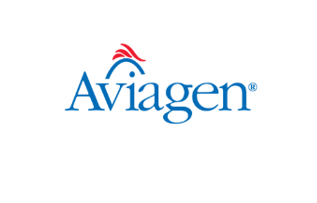



Optimizing nutrition of modern broilers
Aviagen broiler nutrition specificationsArticle Summary – Optimizing nutrition of modern broilers
When considering nutrition’s role in the management of the ever-changing and improving broiler, balanced protein (BP) and feed texture are vital features. Along with affecting productivity, inadequate BP may also strongly affect economic profitability due to potential adverse effects on feed intake, feed conversion, growth rate, and carcass traits. Another important consideration beyond the nutrient profile of the diet is feed texture. Adequate BP and appropriate feed form and particle size are all vital to achieving optimal performance goals.
Follow recommended digestible Lysine (dLys) and digestible Essential Amino Acids (dEAAs)/dLys ratios; this is essential for broilers to achieve the performance objectives for growth, feed efficiency, and yield of carcass components. The use of alternative raw materials as a source of protein and/or the adoption of synthetic amino acids such as L-valine, L-arginine, and L-isoleucine are required to formulate the recommended BP and reduce reliance on soybean meal. Correct feed form and recommended particle size are also essential to maximize feed intake and, thus, performance. Sieved crumble, coarse crumble, and pellets in the Starter, Grower, and Finisher periods are preferred feed forms because they minimize fine particles. Pellet presentation, unlike mash, permits metabolizable energy to be reasonably reduced below Aviagen’s recommendation without impairing live weight and might represent a cost-saving opportunity.
Balanced Protein
The formulation process for broiler chickens accepts the concept of BP, which means that a set of digestible essential amino acids (dEAAs) are accounted for in relation to digestible lysine (dLys). By using the BP profile, nutritionists can modify the protein supply while maintaining the same ratio of amino acids across various production situations and market conditions. The BP profile recommended by Aviagen® (Table 1) results from meticulous experimental and field research; therefore, it should be a standard practice to achieve good biological performance of broilers.
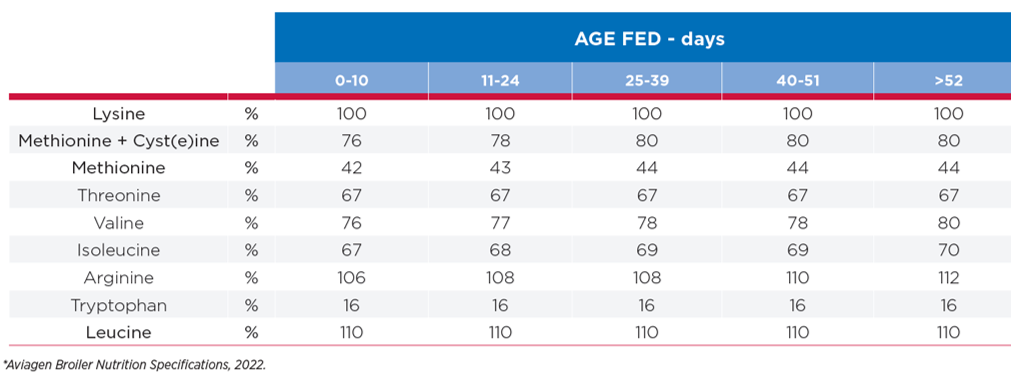
Modern broilers are very responsive to BP, which is the main driver for obtaining optimal performance. Therefore, follow the recommended dLys and dEAAs–dLys ratios during the formulation process; this is essential for broilers to optimize protein utilization and achieve the performance objectives for growth, feed efficiency, and carcass yield components. Adequate BP is achieved by using a variety of vegetable or animal protein sources and synthetic amino acids. There are currently many different synthetic amino acids available for broiler feeds in addition to methionine, lysine, threonine, and tryptophan, such as valine, isoleucine, arginine, and histidine, among others.
Table 2 shows broiler corn-based diets resulting from a formulation exercise without alternative raw materials and with and without L-valine, L-arginine, and L-isoleucine. In general, when formulating a diet using conventional ingredients without alternative raw materials, the supplementation of these synthetic amino acids is necessary to obtain optimal BP; otherwise, suboptimal levels of any specific essential amino acid may result in an imbalanced amino acid profile, which can compromise performance. If these synthetic amino acids and alternative raw materials are unavailable, the least-cost formulation system attempts to achieve their lower limits by adopting intact protein from other ingredients. As a result, crude protein (CP%) might be increased to comply with the recommended BP. Higher CP% might result in increased soybean meal inclusion in the diets and subsequent potential risks, namely gut health issues and poor litter quality, which are detrimental to animal health and welfare. In the case of the non-availability of L-valine, L-arginine, and L-isoleucine, the use of alternative raw material sources of protein (e.g., sunflower meal, canola meal, peas, potato protein, distiller’s dried grains with solubles [DDGS] corn, etc.), may help to reduce CP% and thus the reliance on soybean meal (see Table 3).
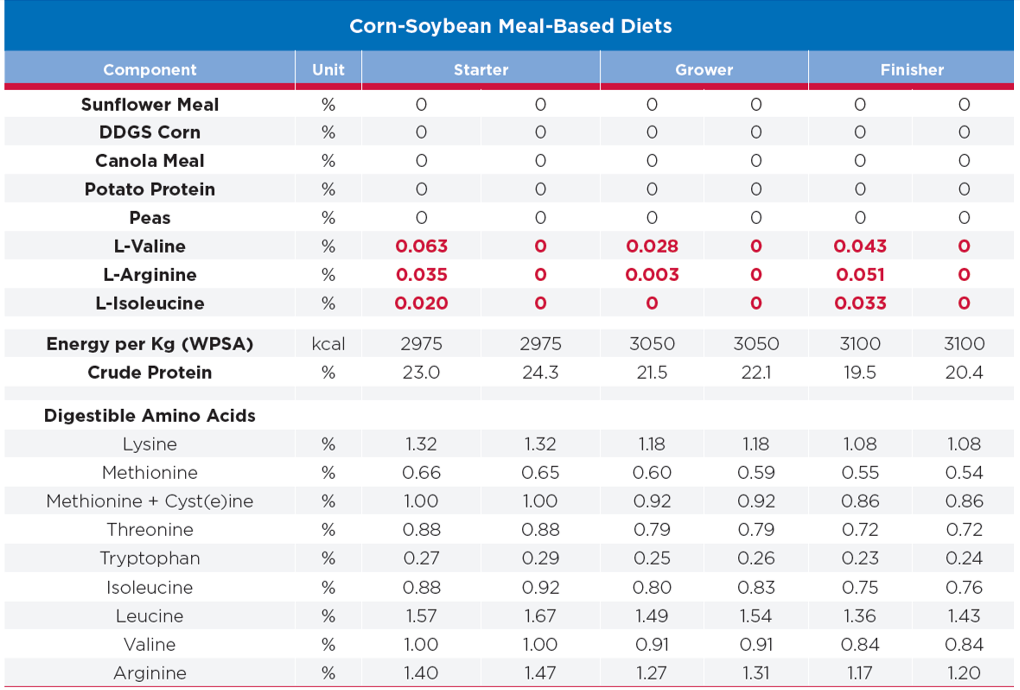
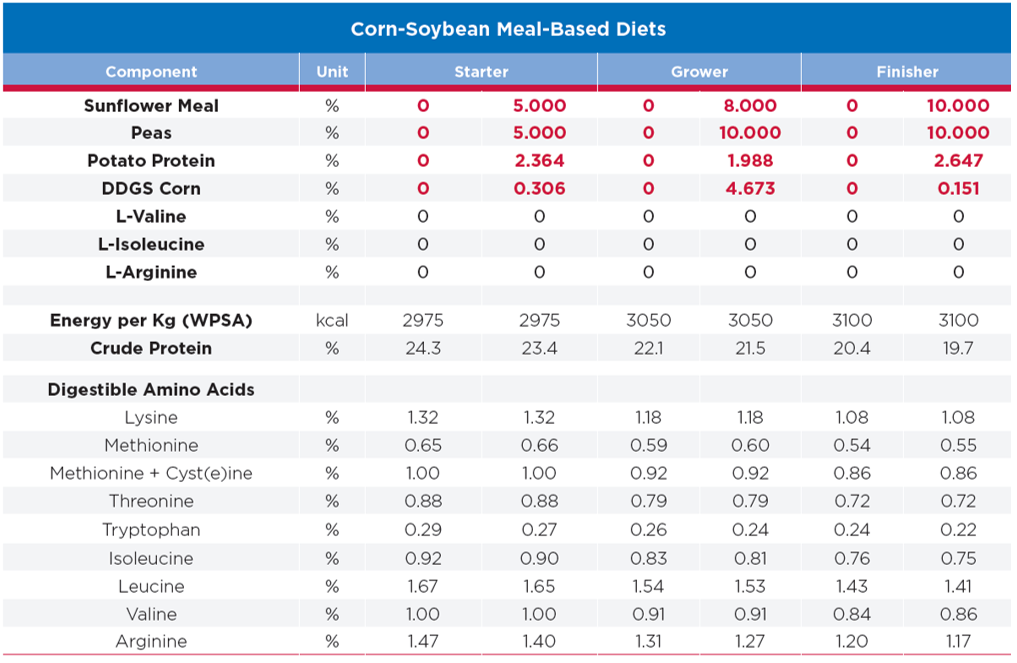
Feed Form and Particle Size
In general, sieved crumble or mini-pellets are adequate in the Starter period (up to 10 days of age), maximizing particles close to 2 mm in size, which the chicks prefer. The 11–18-day period should transition smoothly from sieved crumble or mini-pellets to pellets; as such, mini-pellets (longer than those of the Starter period), coarse crumble, or short-cut pellets are suitable feed forms, maximizing particles close to 3 mm in size, which the birds prefer in this interval. After 19 days, pellets are the preferable feed form, mainly with particles above 3 mm in size. Further details on feed textures are provided in Table 4.
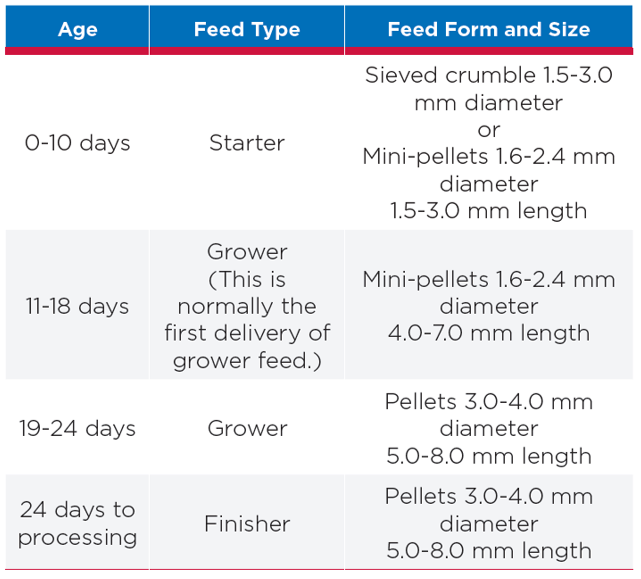
It is essential to minimize fine particles in the feeders across all the diets, with no more than 10% below 1 mm. Research shows that every 10% increase in fine particles (<1 mm) results in a reduction of 40 g (0.09 lb) in body weight at 35 days. Therefore, good crumble/pellet quality is essential. Poor crumbles or poor pellets may result in reduced feed intake, leading to a reduction in biological performance. Additionally, pay close attention on the farm to manage feed distribution to minimize physical deterioration of crumble and pellets.
When considering BP for the feed formulation process, follow recommended dLys and dEAAs/dLys ratios; this is essential for broilers to achieve the performance objectives for growth, feed efficiency, and yield of carcass components. The use of alternative raw materials as a source of protein and/or the adoption of synthetic amino acids such as L-valine, L-arginine, and L-isoleucine are required to formulate the recommended BP and reduce reliance on soybean meal. Correct feed form and recommended particle size are also essential to maximize feed intake and, thus, performance. Sieved crumble, coarse crumble, and pellets in the Starter, Grower, and Finisher periods are preferred feed forms because they minimize fine particles. Pellet presentation, unlike mash, permits ME to be reasonably reduced below Aviagen’s recommendation without impairing live weight and might represent a cost-saving opportunity.
To learn more about balanced protein, feed form and particle size, click here.







